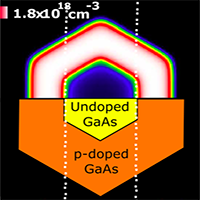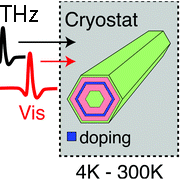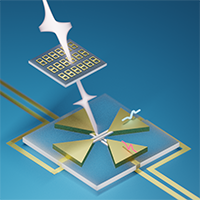- PhD Projects to Start in October 2025
-
PhD / D.Phil topics available in the Johnston Group for an October
2025 are listed here. To apply for these projects you need to submit an application through the University's Postgraduate Admissions Programme to the Department of Condensed Matter Physics . Please follow this link for instructions on how to apply, which includes a list of frequently asked questions. Most students join the group with some form of scholarship. There are a number of funding opportunities available to you.
-
1. Unveiling electron motion at surfaces and interfaces on ultrashort length and ultrafast time scales
-

|
Over the course of the project we will develop and implement a new instrument based on our recent advances in terahertz photoncs. The instraumnet will enable us to gain a deep understand nanoscale charge dynamics in metal halide perovskite semiconductors and semiconductor nanowires. The advances made will contribute to our active existing research programme in developing efficient multijunction solar cells.
|
- 2. Terahertz Photonics with Semiconductor Nanostructures
-
 |
In this project you will develop novel photonic devices to enable a powerful form of ultrafast femtosecond spectroscopy at terahertz frequencies. The photonic devices will be based on ‘nanowires’, which are single crystals of semiconductors, with diameters of only tens of nanometre, but lengths of many microns. Owing to their geometry these nanowires have properties ideal for new and novel device applications. In particular the large surface area to volume ratio of nanowires allows these single crystals be grown in crystal structures that are not possible in the bulk forms of the materials, and allows for unusual light-matter interactions. The large surface area also makes nanowires ideal for applications such as chemical sensing and catalytic conversion. During your D.Phil. the novel properties of nanowires will be exploited for spectroscopy at terahertz frequencies. The terahertz region of the electromagnetic spectrum encompasses a wide range of frequencies from the upper bound of microwave band to the lower bound of infrared light. The spectral region contains a wealth of spectroscopic information for a wide range of physical systems, with THz photons covering the characteristic energy scales of phonon, plasmons and excitons in semiconductors, and the correlations in solids that lead to phenomena such as superconductivity and magnetism. In this project you will develop THz detectors and modulations based on nanowires, and implement them in state-of-the-art THz spectroscopy systems. You will also have the opportunity to exploit these new devices for investigating charge carrier dynamics in other novel semiconductors.
|
-
3. Ultrafast Terahertz Polarimetry
-

|
Single cycles of electromagnetic radiation are the ultimate tools for investigating light-matter interactions. According to the Heisenberg uncertainty principle (or indeed Fourier theory) a pulse of light very well localised in time will have a very broad frequency spectrum, thus single-cycle pulses are great tools for time-resolved spectroscopy. The spectral range of interest for many phenomena in Condensed Matter Physics is the terahertz frequency range, which corresponds to photon energies of ~1meV-20 meV. This is the energy range of the spectral features of charge transport in semiconductors, as well as the energies of quasiparticles associated with correlations, such as superconductor cooper-pair binding energies, phonon energies and exciton binding energies. In this project you will utilise our recent development of cross-nanowire THz detectors (Science, 368:510--513, 2020) to examine the polarisation response of THz metamaterials, and the physics of semiconductors and magnetioc thin films via the THz Hall effect and Inverse Spin-Hall Effect respectively. You will also have the opportunity develop new THz devices as part of this project.
|
- 4. Vapour deposition of Perovskite Solar Cells
-
 |
Metal halide Perovskite (MHP) solar cells have emerged as promising semiconductor devices for next generation photovoltaics. Remarkably, the power conversion efficiency of single-junction solar cells has reached >25%. Efficient tandem solar cells based on perovskites have also recently been achieved. To date most research into MHP solar cells has focussed on solution processing, however this technique is challenging for multi-junction devices. This project will focus developing on highly efficient multijunction solar cells, using a vapour co-deposition technique. The project will involve designing evaporation chamber components optimised of metal halide perovskite deposition, and devising new layer growth methodologies. The candidate will also gain experience in solar cell characterisation and a range of spectroscopy techniques.
|
|
|


